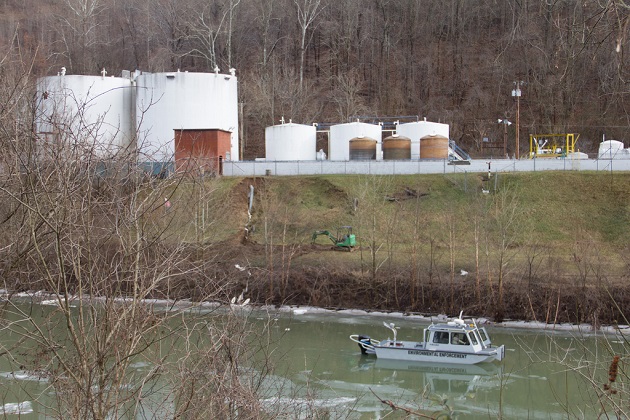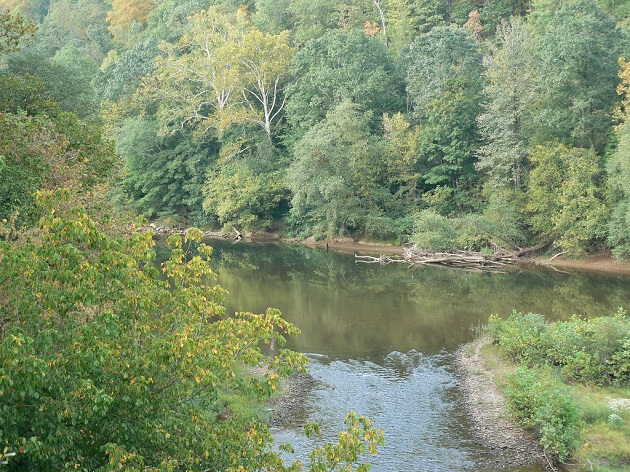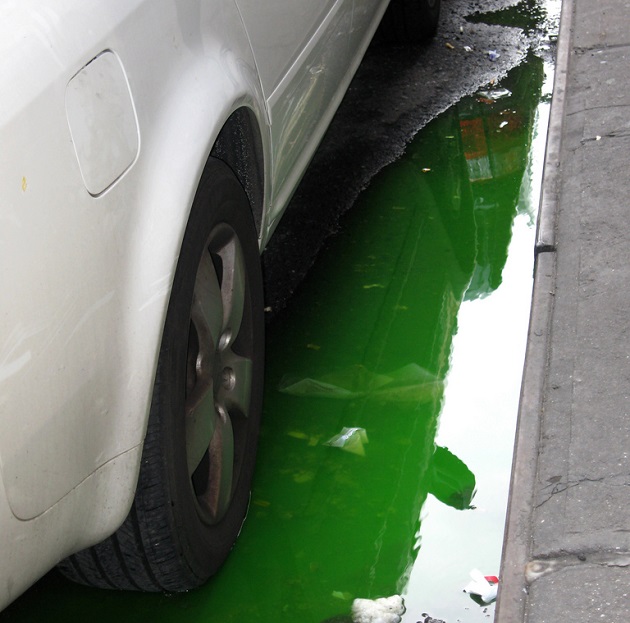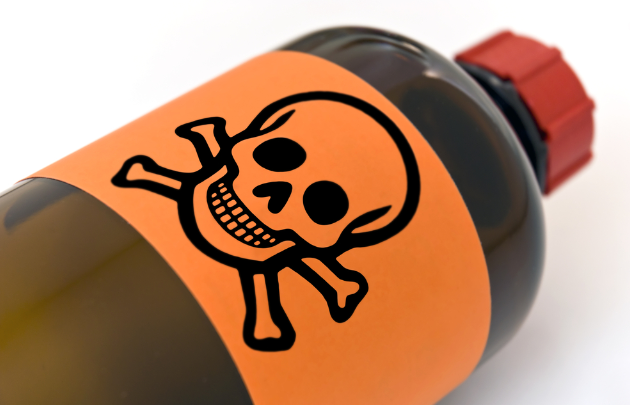This story was originally published in the Guardian and is reproduced here as part of the Climate Desk collaboration. Videos produced by Climate Desk’s Tim McDonnell.
On the morning of January 9, Twylla Bays pumped a syringe of water into the gastric feeding tube in her 29-year-old daughter Cassy’s abdomen. The reaction was instantaneous and violent: in the space of 30 minutes, Cassy, who has muscular dystrophy and is on a ventilator, had seven bouts of diarrhoea.
At about that time, 15 miles away in Charleston, West Virginia, executives of West Virginia American Water and state officials were deciding when and how to tell 300,000 people their water was not safe to drink.
By 5pm, when word reached Twylla Bays that her tap water was so contaminated it was only fit for flushing toilets, she had given Cassy two more 150cc injections of water along with her medicine and food. Each time, Cassy was sick.
“I thought, ‘This is crazy, she must have a virus,’ because she got so sick and her belly was cramping so bad. I didn’t think it was in the water,” Twylla Bays said. “I kept giving it to her, and giving it to her, because I didn’t know.” Her daughter had shown no signs of illness earlier that day, and her health is generally stable.
One month later, three weeks after authorities announced the all-clear for water in her area, Bays is still putting only bottled water into her daughter’s feeding tube, and using only bottled water for her bath.
“I don’t think I will ever drink the water,” she said. “I am too scared. I just wonder how much we don’t know.”
The answer: quite a lot. The officials who made potentially life-altering decisions about the water supply for hundreds of thousands of people in the wake of the January 9 spill of 10,000 gallons of a little-known chemical known as MCHM out of a corroded storage tank and into West Virginia’s Elk River were operating in the dark. There is virtually nothing that is known for certain about the toxicity of MCHM or its effect on humans.
On January 13, the water company cleared the water for downtown Charleston, including hospitals. Two days later, the Centers for Disease Control warned pregnant women not to drink it. Then West Virginia officials chimed in, advising children, the elderly and those with compromised immune systems to avoid the water.
On January 18, state officials and the water company gave the all-clear to all areas affected by the MCHM leak – only to find high levels of the chemical in the water at half a dozen schools. At Riverside High School, a science teacher and several students were taken to the hospital on 5 February after they collapsed from strong fumes coming out of the taps.
Then on January 21, Freedom Industries, the company which owned the tank farm from which the spill came, reported that there had been a second chemical involved in the leak – a mixture of polyglycol ethers, PPH, that had been in the MCHM tank.
Now, more than one month later, the tell-tale licorice scent of MCHM still hangs over the storage tank farm on the Elk River that was the source of the contamination. The hot water carries a faint chemical smell in small communities to the north-west and north-east of Charleston. There are still traces in some homes of the white residue that settled on dishes in the early days after officials told the public it was safe to use the water.
Many of those who do bathe in tap water rinse off afterwards with bottled water to avoid skin irritations and rashes.
“We do not drink it. My pets do not drink it. We don’t cook with it. I still cook with bottled water. I put bleach in every load of dishes,” said Susan Jackson, who lives with her two sons in Clendenin, about 25 miles north-east of the Freedom Industries site.
The skin on her arms and legs, though faintly scarred in rough and red spots from exposure to tap water, is healing, she said. “It was an extreme rash all over my body,” she said. “It was almost like my skin was coming off … since I have been rinsing with bottled water it’s getting better now, but it’s very itchy. It burns.”
Drinking the water was even worse. On January 23, after the all clear, she said she suffered severe stomach pain after taking her first drink of tap water. It was so bad she went to the hospital with fears of appendicitis, Jackson said.
Those symptoms of stomach pain, violent and uncontrollable vomiting and diarrhea as well as skin and eye irritations were consistent with those reported by the nearly 700 West Virginians who turned to the state poison control center and emergency rooms in the aftermath of the spill.
At a congressional hearing into the spill on February 10, weeks after the “do not use” order for water in the affected area was lifted, West Virginia and federal officials performed linguistic contortions trying to avoid a definitive answer about whether the water was in fact safe to drink.
“That’s in a way a difficult thing to say because everyone has a different definition of safe,” Letitia Tierney, the state’s health commissioner, said during the hearing.”Some people think it’s safe to jump off a bridge on Bridge Day. I don’t personally think that’s safe. So everybody has a different definition.”
Tierney then proceeded to pronounce the water “usable for every purpose”.
This kind of confusion has infected every aspect of decision-making about the MCHM spill.
Emergency response officials initially assumed that MCHM posed relatively little danger to humans because it does not appear on federal government lists of hazardous chemicals. “The fallacy of that type of assumption is clear now,” Michael Dorsey, director of emergency response for West Virginia’s department of environmental protection, told the hearing.
What also became clear is the dearth of data about the toxicity of MCHM. The toxicological information section of the safety data sheet prepared by Eastman, which manufactured the chemical, runs to four pages. Heading after heading reads: “No data available”.
The data sheet does reveal that MCHM causes irritation of eyes, skin and the respiratory tract, more so after the chemical is heated.
But only two toxicology studies have ever been conducted on MCHM. Those studies, involving lab rabbits, were focused on a narrow question: the amount of the chemical needed to kill 50 percent of the lab animals outright.
The studies did not investigate other non-lethal effects – which is why the spill so flummoxed officials. “It’s hard to say what’s safe,” Rafael Moure-Eraso, the chair of the federal government’s Chemical Safety Board, told the hearing. “In order to give a scientific answer you have to have scientific information.”
But the findings of those studies – however slim – were the basis for a quick late-night calculation on the night of the spill that set the safe limits of MCHM at 1 part per million, the Charleston Gazette reported.
As it turned out, however, even officials were uncomfortable with that declaration – and the effects of MCHM on humans, while not rising to the definition of lethal, were still dangerous and deeply unpleasant.
There were other gaps. The storage tanks were half a century old. The tanks failed to meet safety standards in an October 2013 inspection by the CSB. The entire facility was in a risky location, 1.5 miles upstream from the main water treatment center, Rafael Moure-Eraso, the chairman of the Chemical Safety Board, told the hearing.
“Perhaps qualified inspectors would have considered aging chemical storage tanks, located just upstream from a public drinking water treatment plant to be potentially ‘highly hazardous’ and worthy of a closer look,” Moure-Eraso said.
Though couched in diplomatic language, it was an unusually strong critique for a federal government official. Moure-Eraso also indicated he had little faith West Virginia would tighten regulations. It was, he told the committee, the third major industrial accident in the state since 2008.
Tierney, the public health officer, told the congressional hearing that she was proud of her department’s response to the spill. Fewer than .5 percent of the 300,000 people on the affected water system had been taken to the hospital after being exposed to the chemical, she said.
That’s about 1,500 people across nine counties, however, and the numbers do not include people like Cassy Bays, Susan Jackson or Jaylianna Bennett, a two-year-old from Nitro, who lives about 15 miles northwest of the spill site.
On 9 February, the one-month anniversary of the spill, Jaylianna’s grandmother, Candase Elswick, decided it was time for her granddaughter to have a real bath. “I thought they were saying it’s safe now,” she said. “Poor little thing, she was so dirty, bathing her with bottled water and she loves the tub,” Elswick said.
Jaylianna started screaming almost as soon as she got in. “She was screaming in the tub like she was hurting. I said: ‘Oh my gosh, it’s burning her alive,” Elswick said. “She screamed and all around her face and her hair where the water runs down was just big red, thick red marks.”
Elswick rinsed her off with bottled water, and by the next day there were only the faintest traces on Jaylianna’s skin.
Elswick’s anger did not subside, however. “The reason I’m angry is all the lies, the unanswered questions,” she said. “It’s like they can tell us anything and we are supposed to do it. We are supposed to believe them. We are supposed to believe everything coming out of their mouths.”
At her home in Tornado, it now takes two hours for Twylla Bays to heat a case of bottled water in the microwave and give Cassy a bath in the inflatable basin on the bed. After Cassy’s reaction on the day the leak was discovered, Bays is taking no chances.
In the 21 years that Cassy has been on a ventilator, the family has been meticulous about protecting her from infection and illness. It’s hard for Bays to think that she, unknowingly, put her daughter at risk. “I hated myself,” she said.
Her other daughter, Kaylla, who is 21, got small pus-filled blisters on her scalp when she took a shower, after the all-clear had been given.
Bays does not bother to contain her fury at the water company and state officials.
“I don’t believe anyone. I don’t believe anything they talk about on the news. I don’t believe our governors, our high officials, I don’t believe any of them are telling us the truth. I believe they are just telling us what they want to tell us,” she said.
“I just feel like we are lab rats. I feel like they are just hanging around to see, and then maybe five years from now they will be able to tell us what happened, because I just don’t think they know, nor do I think they care.”
















